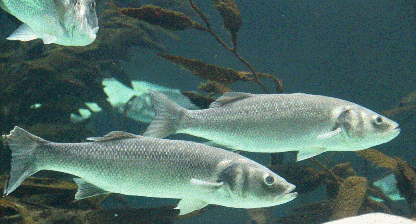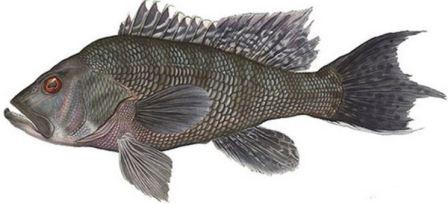Growing seabass, Common seabass

Content
- Seabass description
- What does common seabass look like?
- Where is common seabass found?
- What does common seabass eat?
- Seabass spawning
- Growing seabass in the Mediterranean
- How fast does seabass grow?
- Prospects for growing seabass in the Black Sea
- How to breed seabass in aquaculture
- What to feed seabass when growing
- Growing seabass in pools
- Growing seabass in cages
- Growing seabass in estuaries
- Growing seabass in a pond
Seabass description
What does common seabass look like?

What kind of fish is a seabass, what does a common seabass look like? The body of the seabass is elongated; the back is dark gray, the sides are lighter with a silver tint, the belly is white. Lateral line black. There is a black-gray spot on the upper, inner gill cover. The spiny and soft parts of the dorsal fin are separated by a gap, the pelvic fins are armed with spines. The back of the head and the sides are covered with scales. The common seabass usually has a length of 40 to 65 centimeters and a weight of 300 grams to 7 kilograms, but can reach a length of 1 meter and a weight of 15 kilograms. It is recorded that it can live up to 15 years.
Where is common seabass found?
The common seabass lives in the Atlantic, from Southern Norway to Senegal, and is found near the Azores Islands; the common seabass lives in the Mediterranean and Black Seas. In the Black Sea, it is more common in the southern part of the sea; in the northern part of the Black Sea, seabass is found in single quantities in catches; single entries of seabass seabass into the Tiligul estuary have been noted. Nevertheless, in the Azov-Black Sea basin, seabass can be grown in large quantities.
The common seabass is a schooling fish at a young age that stays close to the shore; adult individuals are predators that prefer to stay alone away from the shore.
It lives in coastal waters, at depths of up to 100 meters. seabass is an ordinary plastic species that can withstand large changes in salinity and water temperature. It is primarily a fish of the open sea, but moves into brackish and fresh waters such as lagoons and estuaries.
What does common seabass eat?
Large individuals of sea bass feed on small fish (anchovies, gobies, mullets), while in the Mediterranean they do not refuse cuttlefish, squid, and octopuses. It also feeds on shrimp and crabs, even worms. Juvenile sea bass feed primarily on invertebrates such as clams, shrimp and sandworms.
Seabass spawning
How does common seabass spawn? Seabass spawns off the coast in a desalinated zone, releasing pelagic eggs with a diameter of 1.1 mm with a large drop of fat.
Growing seabass in the Mediterranean
What is seabass for the Mediterranean? Sea bass meat is very tasty; it has firmly taken its place in the cuisine of the Mediterranean from Greece to Spain. Seabass is in demand on the market because of its good taste and smell, it is easy to cut (fillet yield is 40%), and is suitable for various processing methods (pickling, smoking, etc.). How to cook seabass?
Therefore, seabass is bred in Mediterranean countries. Seabass is one of the species of fish that has long been bred in lagoons using the pasture method. In the Mediterranean, in addition to Europe, seabass is grown in Egypt and Turkey.
Fish farms in Greece are the leading producers of common in Europe, producing 100,000 tonnes of each year, representing over 90% of European production. It is believed that the volumes of leaves grown in Turkey are the largest in the world. In France, the cultivation of seabass in RAS has been established. Common seabass are often grown in organic aquaculture; the leaders in this industry are Italy, Spain, Croatia, and Greece.
How fast does seabass grow?
Seabass grow relatively quickly. In many ways, the growth rate of seabass depends on factors such as water temperature, availability of food and other factors. In the second year, the weight of seabass is 0.2 kg. It reaches commercial size with a weight of 250 grams, which in the Mediterranean Sea takes about 20 months.
Prospects for growing seabass in the Black Sea
Without requiring special conditions of maintenance, seabass can become a promising object of cultivation in Russia, Ukraine, Georgia, Bulgaria, and Romania. To grow seabass, you can create both cage farms and grow seabass in fenced off estuaries. You can grow seabass in pools and ponds.
How to breed seabass in aquaculture
To play For breeding producers and repairs, sea bass are caught in the sea in winter. The fish placed in the pools are kept for a period of time and undergo natural spawning. To do this, they are injected with gonadotropin in doses of 800... 1000 IU per 1 kg of body weight. Males mature without injection. Offspring are obtained in January both ecologically, by provoking natural spawning in the pool, and artificially - by squeezing out ripe eggs (possibly after a pituitary injection) and inseminating the eggs with sperm in a “dry” way. By adjusting the light regime and water temperature, it is possible to achieve a shift in spawning time.
Incubation of eggs, which lasts 90...100 hours, is carried out both in pools and in apparatus. Typically, containers with a volume of 2 m3 are used, provided with warm and cold water, as well as an aerator.
The larvae are raised in the same or larger volume (10 m3) containers with an initial planting density of 20...100 pcs/l and intensive water exchange for 45...70 days.
What to feed seabass when growing
During this period, larvae are fed only with live food - zooplankton; later he may consume still food. The feeding regimen is as follows: the first 6...8 days - yolk nutrition; up to 15 days - Brachionus and other rotifers; up to 40...50 days - Artemia metanauplia; up to 60 days - frozen adult brine shrimp, mixed feed and other fixed food.
Rotifers and brine shrimp are cultivated in the hatchery specifically for raising larvae. The former are kept on algae, baker's yeast, etc., the latter are fed with feed based on brewer's yeast, fats and vitamins.
Pools for growing are plastic or concrete cylindrical containers 0.5...1 m long with a tangential flow of water (i.e. at an angle that ensures rotational movement of water) and a central outflow.
Growing seabass in pools
Commercial sea bass fish are also grown in the same pools.
Growing seabass in cages
For growing and commercial cultivation of seabass, mesh cages made of delhi suspended on pontoons or submerged cages attached with anchors are also used. Growing in cages is more profitable, since it does not require large expenses for pools, pumping stations and other structures.
To prevent cannibalism, fish must be sorted regularly. It reaches marketable weight (250 g) in warm (Mediterranean) water within 20 months at a growing density of 20...25 kg/m3. The difference in the mass of individual individuals can reach 150 g.
The lowest water temperature is 11 °C, the maximum is 25 °C, the average is 18 °C.
Growing seabass in estuaries
Seabass is also grown in estuaries, where fish are introduced, or they passively enter from the sea during the migration period in March - June, when the length of the fry reaches 5... 10 cm.
Growing seabass in a pond
In ponds (salinity 0.5...18%o, pH 7.1...8.5) they begin to grow seabass with a length of 20 cm, a weight of 80 g, a temperature of 8...31 "C and a density of up to 2 thousand pcs/ha The survival rate of fish with an average weight of 200...300 g is 40...50%.